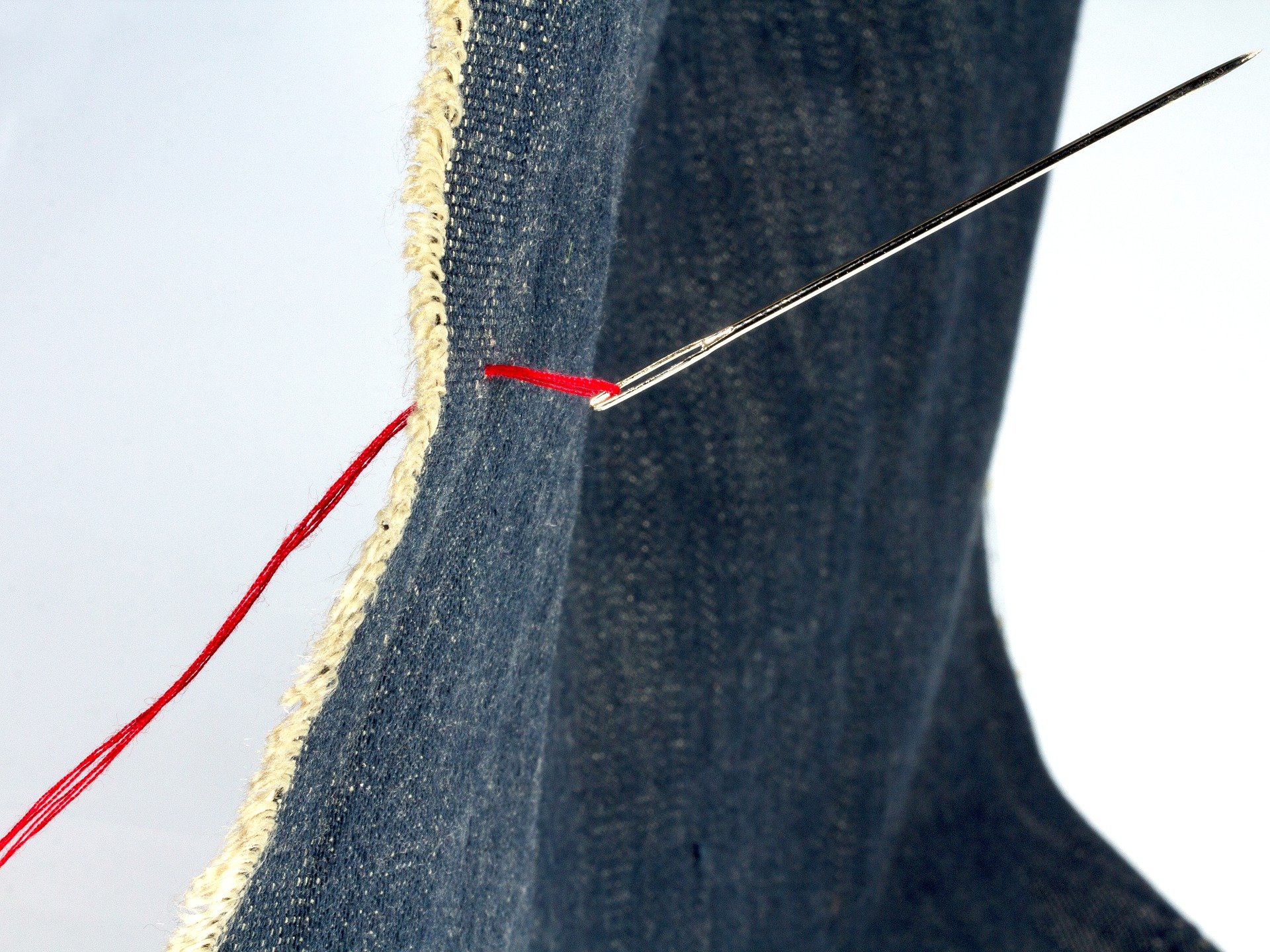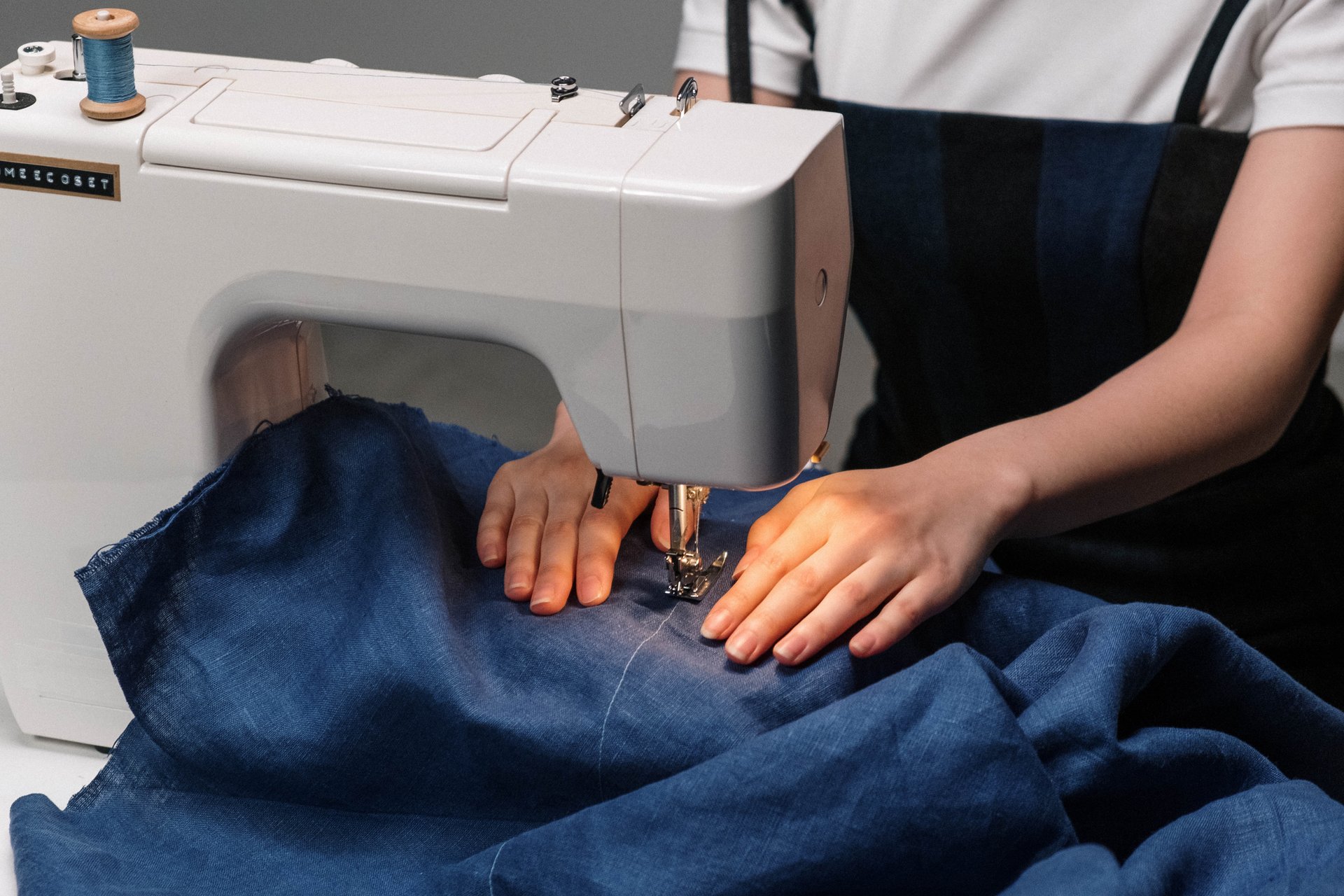If you purchase one of the products recommended in this article, I might receive a small affiliate commission. Thank you for your support!
It might be time to correct that old “man’s best friend” adage to include our greatest companions: jeans. They’re comfortable, stylish, and versatile for any occasion. Virtually everyone owns at least one pair of jeans and there’s a cut and fit for everyone. One of the more popular fits is tapered jeans which are similar to skinny, straight, and slim fit jeans except that instead of being straight up and down, they get narrower from hip to ankle. This creates a sleek look that removes that less than favorable bunching around the ankle some jeans cuts provide.
You don’t have to run to the nearest Levi’s, however, you can learn how to taper jeans at home. You don’t need super-advanced sewing skills as you can easily achieve this by hand but you can also learn how to taper your jeans without sewing! Tapering your jeans is a great way to switch up an old pair, fix the fit of too-long or ill-fitting jeans, and better show off your shoes.
How to taper jeans without sewing
Fortunately, you don’t need a machine or any sewing capabilities to taper your jeans. You can simply just cuff them with the pin roll method. Pin rolling is great if you want a temporary change to your fit, it doesn’t require any tools or clips to be held together and it’s highly adjustable.
Step 1: You’ll have to start with your jeans on your body. Pinch the fabric from the inseam, i.e. your inner leg, with your thumb and index finger, and pull the fabric to your outer leg seam. Hold it in place with your other hand.
Step 2: Once you have your fold at the tightness you’re comfortable with, use your other hand to roll up the hem of your jeans. It’s best to roll the hem up twice for greater security but if you’d like, you can go three or four more times.
Read: How to Hem Jeans With Original Hem
Step 3: Repeat on the other side and that’s it. It’s super simple and quick and you can go show everyone you know how to taper jeans without sewing.
When pinching your jeans, note that the more fabric you pinch between your fingers the tighter the roll will be. To get symmetry, try to make note of how much fabric you’re pinching and how tight it feels around your ankles or shins. If you’ve rolled your pants tight enough, they should stay in place all day but you can also secure the roll with safety pins.
Read: How to Wear Jeans That Are Too Long
How to taper jeans with a needle and thread
For a more permanent taper, you can very easily hand sew your jeans in under an hour. This is perfect for both beginners and experienced sewists alike.
All you’ll need is pins, a ruler, a fabric marker (chalk, fabric pens or even a light pencil will do), scissors, sewing needles, and polyester or cotton thread in a matching color. A seam ripper is optional. For a better hand sewing experience, opt for thread wax which coats your thread to prevent it from tangling and knotting.
Step 1: With your jeans on your body inside out, choose the point on your shins from which you would like your pants to taper. The great thing about altering your own pants is that you have free reign to decide how long or short your taper line will be. Most people traditionally begin at the knees of mid-calf but if you’d like, you could start at your hip or mid-thigh.
Read: How to Fix Holes in Jeans in the Inner Thigh
Pinch the fabric and outer leg side seam and mark it with pins placed vertically as you go down to your ankles. You can also mark this out with your chosen fabric marker but you’ll get a better idea about fit and comfort if you can hold it in place with pins.
Step 2: Lay your jeans, still inside out, on a flat surface and use your fabric marker and a ruler to mark a straight line from your pins. You can also measure how far in your line goes from your starting point and at your ankle to replicate it on your other leg.
Step 3: For better results, you will want to unpick the stitches that are holding the hem of your jeans up at the side seam you’re working on. This will allow you to create a smooth line without any bulk at the bottom which can ruin the clean look of the taper. You can, of course, skip this step especially if your jeans are very lightweight.
Step 4: Since you’re increasing the tightness of your pants at this point, the seam you’re going to create will be taking a lot of stress from the pressure of your leg pushing through the opening. You need to create a durable and strong seam to prevent ripping. This is usually a no-brainer with machine stitching but fortunately, hand sewing has been around for much longer and you can use a centuries-old technique: the running backstitch.
To complete the stitch, you’ll thread your needle, make a knot at the end and push your needle through the jeans until the knot catches. Instead of pushing your needle ahead of this anchoring point, you’re going to make it come up behind the thread and that creates a backstitch. You can then push your needle over and under the thread for a few stitches – this is the running stitch. You will create another backstitch after every 3-4 running stitches until you reach the hem of your pants where you will finish the seam with a backstitch and tight knots.
Step 5: You can either cut off the excess fabric from your jeans or leave them as is. Just note that your jeans will fray if you cut too close to the seam and potentially come undone so try to leave at least ½ an inch of excess. If you had elected to unstitch your hem, you can now return it with a simple running stitch and enjoy your newly tapered jeans.
Read: How to Fray Jeans
How to taper jeans by machine
Tapering your jeans by machine is the fastest and most durable way to permanently alter your jeans. To taper your jeans by machine, all you will need is your sewing machine, of course, scissors, a ruler and pins, a fabric marker, a seam ripper, and, if you have one, a serger/overlocking machine and matching thread.
Step 1: Put your jeans on inside out and begin to mark out your tapering line with pins on the outer leg seam. You’ll want to place them vertically so you can really feel the fit and give off your new demarcation.
If you’d prefer, you can pin both inside and outside seams for balance but the end product is generally the same and there’s less room for error when you’re working with only one seam.
Step 2: Lay your pinned jeans on a flat surface and use a fabric marker and a ruler to straighten and define the line you’ve made with pins. You can also use your first line as a measuring guide for your other leg to ensure symmetry or you can do it by eye.
Read: The Best Sewing Machine for Jeans
Step 3: Remove the stitching at the hem of your seam to create a smooth line. You may want to test out a similar fabric on your machine to figure out the best stitch length and tension for your jeans. It will also help to get denim or heavy-duty needle, especially if you’re working with thick denim or a stretch needle if you’re tapering stretch denim.
If you don’t have any scrap fabric, you can use the excess from your tapered jeans but be careful to not cut off too much in case you need to still let them out. Once you’re sure of your tension and stitch length, you can run your jeans through your machine making sure to backstitch at the beginning and end of your seams.
Step 4: If you have a serger, you can cut off the excess fabric and finish the seams that way or you can leave quite a bit of excess to prevent fraying. You will simply just roll back your hem and straight stitch it in place to finish the process.
Read: How to Fix a Hole in Jeans Without a Patch
With any of these easy steps, anyone can learn how to taper jeans in less than an afternoon. In fact, if you put on your favorite show or some music, you can alter several pairs on one of your days off. If you’ve chosen the pin roll method or kept the excess fabric in your jeans with the sewing methods, you will always have the option to let out or jeans or return them back to normal but considering how great your own customized to you tapered jeans will look, it’s highly unlikely you’ll even want to.




